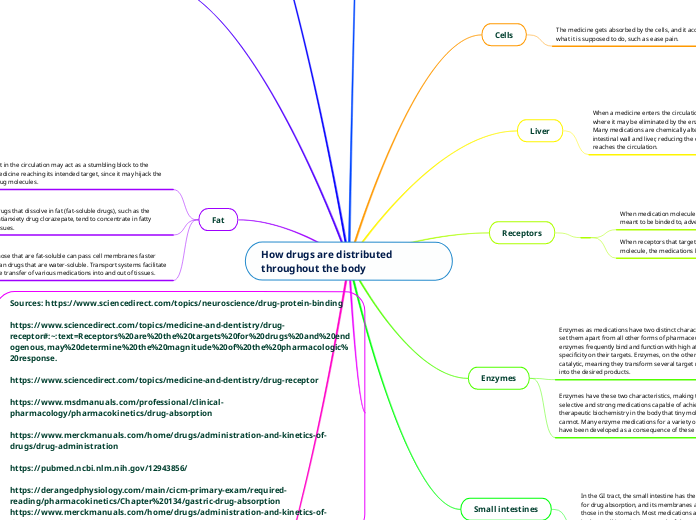How drugs are distributed throughout the body
Cells
The medicine gets absorbed by the cells, and it accomplishes what it is supposed to do, such as ease pain.
Liver
When a medicine enters the circulation, it goes to the liver, where it may be eliminated by the enzymes that are created. Many medications are chemically altered (metabolised) by the intestinal wall and liver, reducing the quantity of drug that reaches the circulation.
Cholic acid may assist restore normal liver function by: Maintaining bile acid balance under normal physiologic settings via the farnesoid X receptor (FXR). 1 Keeping hepatotoxic atypical bile acids from accumulating and causing liver damage
Receptors
When medication molecules attach to receptors that aren't meant to be binded to, adverse effects might occur.
When receptors that target the organ grab onto the drug molecule, the medications know where to go.
Enzymes
Enzymes as medications have two distinct characteristics that set them apart from all other forms of pharmaceuticals. First, enzymes frequently bind and function with high affinity and specificity on their targets. Enzymes, on the other hand, are catalytic, meaning they transform several target molecules into the desired products.
For chronic pancreatitis, pancreatic enzymes are used. For these individuals, medical therapy frequently includes the prescription of pancreatic enzyme preparations. This approach is based on research that suggest pancreatic enzymes have a positive impact on a variety of outcomes, including abdominal discomfort, weight loss, painkiller usage, fatty stools, and overall quality of life.
Enzymes have these two characteristics, making them highly selective and strong medications capable of achieving therapeutic biochemistry in the body that tiny molecules cannot. Many enzyme medications for a variety of illnesses have been developed as a consequence of these properties.
Small intestines
In the GI tract, the small intestine has the most surface area for drug absorption, and its membranes are more porous than those in the stomach. Most medications are absorbed largely in the small intestine as a result of these factors.
Corticosteroids, or commonly just referred to as steroids, are a common medication used in the treatment of inflammatory bowel disease
Circulatory
The medications go through the circulatory system to the liver and the targeted location.
Anticoagulants are medicines that prevent the blood from clotting as quickly or as effectively as normal. Some people call anticoagulants blood thinners. However, the blood is not actually made any thinner - it just does not clot so easily whilst you take an anticoagulant.
Protein
Proteins take over the medicine molecule, preventing it from reaching where it's supposed to go.
Monoclonal antibodies (mAbs or MoAbs), which are man-made copies of immune system proteins, can be particularly beneficial in the treatment of cancer because they can be engineered to attack a specific component of a cancer cell and so hinder the carcinogenesis process.
Stomach and Stomach acids
The medication is dissolved by gastric acid in the stomach. The medication is absorbed into the circulation through the stomach lining.
The medications, on the other hand, may be destroyed by the stomach. When a medicine is decided to be supplied through inhilator or injection, this is what happens.
Pepto-Bismol relieves upset stomach by binding with the mucoproteins in the stomach lining and providing a protective coating that soothes irritation and provides fast relief from upset stomach and indigestion.
A sufficiently large concentration gradient to promote simple passive diffusion is another element that favours medication absorption in the stomach. This necessitates a low-potency drug (i.e. given as a very large dose). It also helps if the medicine has a tiny molecule that can easily pass through the gastrointestinal mucous barrier.
Fat
Fat in the circulation may act as a stumbling block to the medicine reaching its intended target, since it may hijack the drug molecules.
Drugs that dissolve in fat (fat-soluble drugs), such as the antianxiety drug clorazepate, tend to concentrate in fatty tissues.
Atorvastatin (Lipitor) is a cholesterol-lowering drug that is often prescribed to persons who have excessive cholesterol or heart disease. It's also used for those who have a higher risk of heart disease, such as diabetics, even if their cholesterol levels are normal.
Those that are fat-soluble can pass cell membranes faster than drugs that are water-soluble. Transport systems facilitate the transfer of various medications into and out of tissues.
